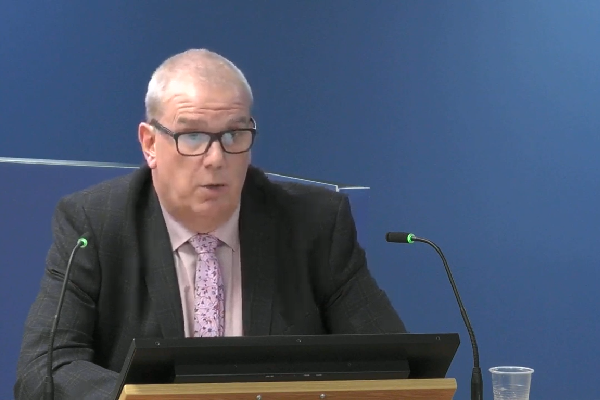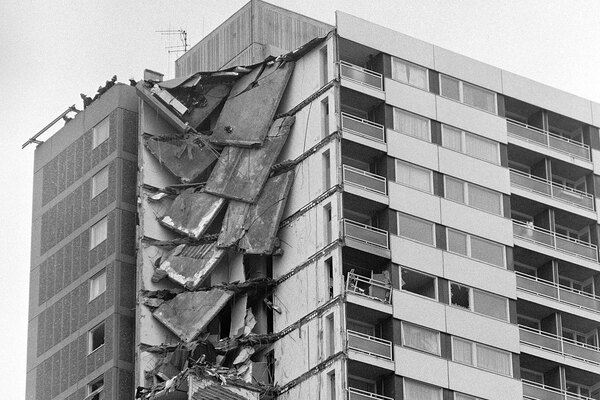NHBC fire engineer accepts ‘corrupting’ influence of desire to collaborate with industry
A former surveyor at the National House Building Council (NHBC) has accepted that a desire to “collaborate” with industry over its use of combustible insulation was a “corrupting” influence for a firm required to enforce fire safety regulations.
Giving evidence to the Grenfell Tower Inquiry on Monday, John Lewis was repeatedly grilled about the giant building control inspector’s willingness to sign off projects containing combustible insulation despite being warned about its safety.
He was also asked why the NHBC led a process which resulted in the production of industry of guidance which said cladding systems with combustible materials could be used on high rises, provided they were justified by the use of a desktop study.
This was a more permissive position than the limits contained in official guidance at the time.
Under questioning, Mr Lewis accepted that a desire to “collaborate” with industry was a “corrupting” influence on the firm, which holds responsibility for signing off more than half the country’s construction projects as compliant with guidance.
He said the NHBC “didn’t want to hold up the industry” by refusing to accept the use of plastic insulation boards, despite fears about fire safety.
The inquiry has been examining the NHBC’s role in the use of combustible insulation in high-rise cladding systems, which became widespread in the years before Grenfell despite official guidance apparently requiring the use of less combustible products unless a system had passed a large-scale test.
It has previously heard how manufacturer Kingspan did one of these tests on a system featuring its combustible K15 insulation in 2005.
Despite this pass only allowing the material’s use in the specific system tested, Kingspan marketed K15 for much wider use on high-rise buildings in the years that followed.
The inquiry has heard that concerns about this were raised with the NHBC from as early as summer 2013.
It began seeking more test data from Kingspan, threatening to stop accepting the product for use in high rises if it was not provided.
But it did not follow through on its threat while it was waiting for these assurances, nor issue any warnings about the projects it had already signed off.
Instead, it began to work with other building control bodies on industry guidance – Technical Guidance Note 18 – which said cladding systems which had not passed any tests could be considered compliant if the builder obtained “a desktop study report” advising whether or not it would comply if tested.
Lead counsel to inquiry Richard Millett QC asked several times why Mr Lewis, who co-wrote this guidance, believed that it was acceptable.
Mr Lewis said: “It didn’t seem out of the question that you would go back to the manufacturer for advice on their project.
“You would be expecting that the manufacturer was giving good advice. It was possibly a misguided way of doing things.”
In his witness statement to the inquiry, Mr Lewis said: “Driven by increasing thermal insulation targets, builders were often looking for thinner insulation products, as well as more cost-effective solutions than using such materials.
“We wanted to document another option available to them if they could not comply with the first two options.
“I therefore drafted option three [the option to use a desktop study].”
But Mr Millett asked on Monday why it was the NHBC’s task to help the profession to find other ways of being compliant.
Mr Lewis said: “We knew that these option three reports could be done and at the time we weren’t being told that insulation was the big fire risk that possibly it was.”
He added: “We didn’t want to hold up the industry. We were aware of the need to have high levels of insulation to achieve other thermal requirements.
“We were just trying to reconcile the two things and bring them together.”
Mr Millett said: “Did you understand at the time that a regulator’s role was ruthlessly and fearlessly and independently to consider what was in front of it and decide whether it passed and complied or failed because it didn’t comply?
“Did you consider that it was not part of the regulator’s role to help or guide industry to get to a place… and it was up to government to change the guidance?”
Mr Lewis agreed that was what the NHBC knew was its “bottom line”.
“But equally the construction industry does work by a process of collaboration between all parties… and in a way the regulators as the goalkeepers,” he said.
Mr Millett said: “But if the goalkeeper is collaborating with the striker, what happens to the match?”
Mr Lewis said he can understand that now, but building control at the time “wanted to move on from the days of being very rigid to the point where it was collaborative”.
Mr Millett said: “Did it ever occur to you that this act of collaboration was corrupting because it would undermine the ruthless and fearless independence of the regulator?”
“I think we probably knew that,” Mr Lewis said, adding he “couldn’t give any reasons”, just that it was the “thinking of industry at the time”.
After first raising concerns with the manufacturer in autumn 2013, the NHBC met with Kingspan in January 2014 and asked it to provide further test evidence to support the use of its insulation on high rises.
It continued to sign off on projects using the insulation while waiting for this.
The inquiry has previously seen that Mr Lewis continued to raise concerns about K15. He warned in October 2014 that the product was “an accident waiting to happen”.
The NHBC ultimately wrote to Kingspan in February 2015, saying it would issue a warning to clients that the material was non-compliant and it would not accept its use without justification on high-rises.
The insulation manufacturer responded with the threat of a legal injunction for defamation.
In the end the NHBC did not stop accepting the use of Kingspan’s material, saying instead that its use would need to be justified through a desktop study.
Mr Lewis, who now works as a senior fire engineer at developer Taylor Wimpey, was pressed numerous times throughout the day as to why the NHBC failed to reject K15 as non-compliant.
He said it was “not his position to do”.
But he added: “To suddenly pull the rug from the acceptance of Kingspan was going to leave an awful lot of buildings that could not complete in time for the end of the year and that was a cut-off date in most house builders’ diaries.
“It would have had a massive knock-on effect across the industry and it had to be handled very carefully. That was what my managers were aware of…
“We were in probably less than half the cases the building control body on these jobs so we would have been the only ones going and saying this is clearly wrong when other building control bodies… were saying it’s absolutely fine.
“It would have been very difficult to justify in that way.”
Last week, Inside Housing revealed that Kingspan has temporarily stopped distribution of K15 – which remains a market leading product for medium-rise buildings – after an order from the government’s product safety watchdog. This followed fire tests which showed it failed to obtain its advertised grade.
Inside Housing has also seen a desktop study ultimately signed off by the NHBC where a failed test on a system containing K15 was used as part of the evidence for its suitability.
The inquiry continues on Tuesday with further evidence from Mr Lewis.
Sign up for Inside Housing’s weekly Grenfell Inquiry newsletter
Each week our sister publication Inside Housing sends out a newsletter rounding up the key news from the Grenfell Inquiry, along with exclusive analysis of what it all means for the social housing sector.
Already have an account? Click here to manage your newsletters













